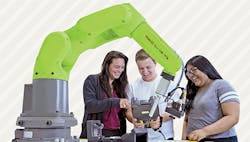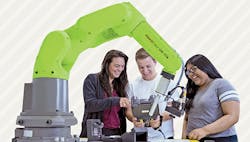Humans and robots go to school together, IFR reports
Source: FANUC America, International Federation of Robotics
A push to automate is changing the way humans and machines work together. The number of industrial robots installed in factories reached about 3 million units worldwide in 2020 – more than doubling in ten years, according to the International Federation of Robotics (IFR). The IFR has researched how robotics training shapes current and future workforce education, enhancing skills development for employees.
“Automating dull, dirty and dangerous tasks is changing job profiles of factory workers for the better,” said Milton Guerry, IFR president. “Academies run by robot manufacturers play a key role in making this transition possible. Employers send thousands of workers to robotics training every year.”
Robot manufacturers drive education
Robot manufacturers like ABB, FANUC and KUKA register between 10,000 and 30,000 participants in their robot classes across more than 30 countries every year. The training programs range from basic programming for the first-time user to complex workshops.
“The automotive industry traditionally plays a leading role in upskilling workers for the use of robotics,” said Gerhard Müller, vice president global customer services, KUKA. “Volkswagen, for example, decided to host one of our KUKA colleges directly at their headquarter factory in Wolfsburg, Germany. We start with basic training for people who have never used a robot before. For professionals, we offer about 70 different modules ranging from basic operation and programming to complex commissioning of entire robot systems.”
Alexander Bongart, head of the FANUC Academy Germany, added: “Training programs set up by international robot manufacturers provide key skills for the industrial workplace of the future. What participants learn in our headquarter school near Mount Fuji in Japan is what they also get in our training schools established in the United States, Europe or China. Robotic certificates for workers are valid around the globe and qualify for fantastic new career opportunities. This is not limited to the classic adopters of robotic and automation like the car industry but also true for small and midsized companies from a wide range of branches.”
As more industries move toward automation than ever before, robotics training also becomes part of public education in the U.S., Europe and Asia.
“In China, for example, ABB Robotics’ cooperation with vocational schools dates back to 12 years ago,” said Arno Strotgen of ABB`s Robotics & Discrete Automation business area. “Today, 700 vocational schools are part of the project. We use industrial robots for our trainings and provide 1,000 new robots every year, only to China. At the same time, simulation software and augmented reality open up new ways of teaching. The days when everyone needed to be an engineer to handle a robot are definitely over.”
Education policies need updates
“Governments face the need to update their education policies. The qualification to program and use a robot is an essential skill required of workers before they even enter a job on the shop floor,” said IFR´s Guerry. “To enable the transition, robot manufacturers are the best possible partners, providing the right skills necessary to work with intelligent automation systems. The International Federation of Robotics invites public authorities to team up with the experts and to use their know-how to deliver education for the workplace of the future.”


